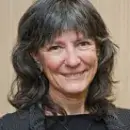
Susan J. Goldin-Meadow
Which properties of language are so fundamental that they will arise in a communication system even if the creator of that system does not have access to linguistic input? Goldin-Meadow’s work addresses this question by observing the self-create gestures, called homesigns, that profoundly deaf children produce when they have not been exposed to sign language by their hearing parents. Homesign offers insight into the linguistic properties that are at the core of human language––the properties are not only those that children can invent on their own, but they are also properties that conventional sign languages are likely to have contained at the earliest stages of their creation. To explore this prediction, she is studying homesign in Nicaragua, where a new sign language has been evolving since the late 1970’s. Her goal is to determine which aspects of Nicaraguan Sign Language are already present in homesign and which need other factors (e.g., a community of users, fresh generations of signers) to appear.
Can the gestures that hearing speakers (adults and children) produce when they talk play a role in learning––in particular, in the transition from an understanding that is grounded in movements in space to an understanding that is abstract and generalizable? The gestures that hearing speakers produce when they talk are robust––they appear in congenitally blind individuals even though they have never seen anyone gesture, and in deaf children who use sign language as their primary language. These gestures often reflect thoughts that don’t appear in the speaker’s language, sign or speech. But gesture can do more than reflect thought––it can play a role in changing thought. Goldin-Meaodw is currently exploring the mechanisms underlying this phenomenon.
What role does linguistic input, both spoken and gestured, play in the acquisition of language. Goldin-Meadow has videotaped 60 typically developing children and 40 children who suffered pre- or perinatal focal brain injury from 14 months through 10 years during naturalistic interactions at home. Many of these children are at risk for school failure, either because they received inadequate linguistic input prior to school entry (environmental risk) or because they suffered brain injury prior to or at birth (organic risk). Her goal is to understand the joint effects that brain injury and environmental variation can have on how children use language and gesture to communicate and engage in higher order thinking.